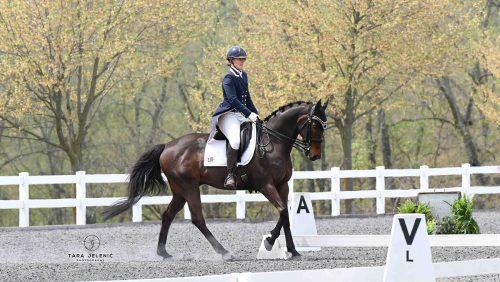Although Sunday morning was a little dreary, spectators were nothing but enthusiastic for Day 2 of New England Dressage Association Fall Symposium with Carl Hester.
Read all about Day 1’s action in “The Oprah Of Transitions.”
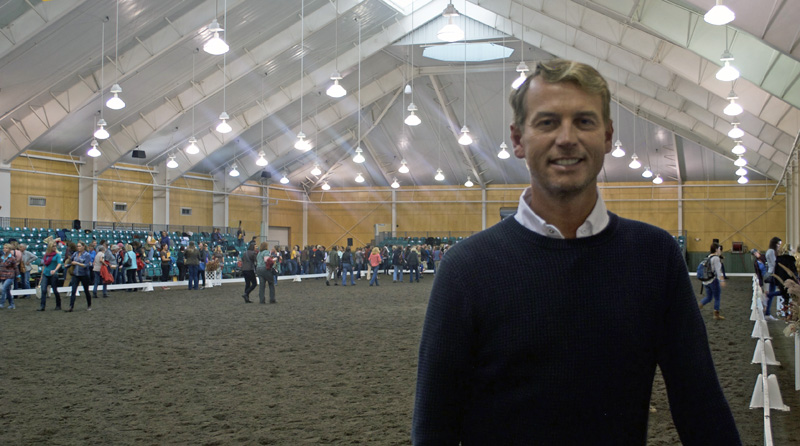
Carl Hester at the New England Dressage Association Fall Symposium. Photo by Sara Bradley
Once again the day started off with the baby horses, and for the 4- and 5-year-old classes we had some different participants today.
Cara Klothe, head trainer for Rolling Stone Farm (Pa.), was up first on the lovely chestnut mare, Dhanube. Similar to yesterday’s 4-year-old candidate, Dhanube was remarkably cooperative in what can only be a tense atmosphere for a young horse. She was truly lovely, and Hester had many compliments for her.
His advice for Cara was to strive for rhythm (the theme of the day!), relaxation, and equal contact to give the young horse a feeling of success. He advised all young horse riders to keep schooling sessions short. “The horse won’t be physically mature until 7, so 20 to 30 minutes max,” Hester advised.
He encouraged Cara to “push the head away” in the walk to increase stretch and length of stride.
Our 5-year-old for Day 2 was Don Dreamer, with Jessica O’Donnell in the tack. Hester had Jessica work on stretching right off the top, not only to improve swing, but also to help the horse become happier in the mouth. With his typical humor, Hester advised Jessica to allow herself to relax the horse into a longer frame. “You’re only being watched by 1,000 people after all,” he said, slyly.
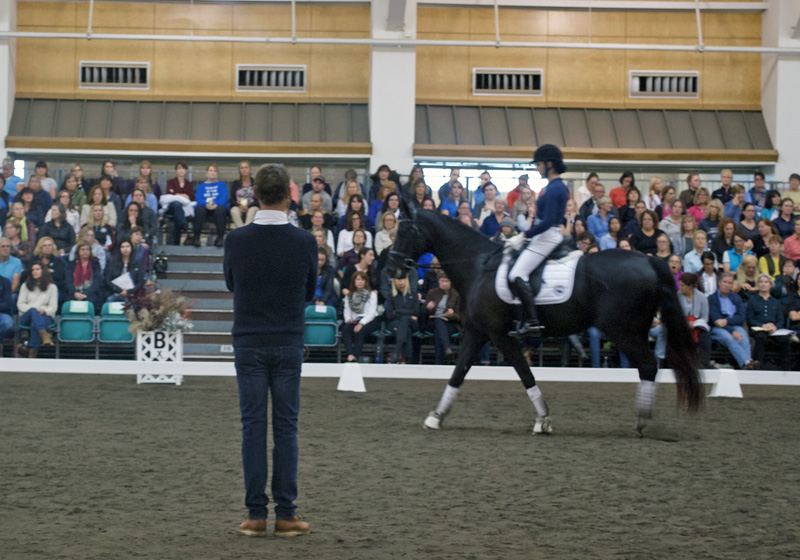
Hester teaching Jessica O’Donnell. Photo by Sara Bradley
Don Dreamer received compliments for his steady attitude, which brought up the conversation about what a trainer might prefer in a Grand Prix-bound young horse. A steady Eddie or a fire-breathing dragon? Hester made the good point that it could be either very easily, depending on the horse’s rider and its training. (I appreciated this, as I’d take a pass on the fire-breather!)
We saw this pair work through some “baby” simple changes, as well as transitions between all three gaits on a long rein to test developing self-carriage. “When a horse can do all transitions on a loose rein, he is developing balance,” said Hester.
Every exercise that was done with the young horses was meant to develop straightness, thoroughness and much relaxation and rhythm.
The lovely Giuliano B returned as our 6-year-old horse, with Karin Persson riding.
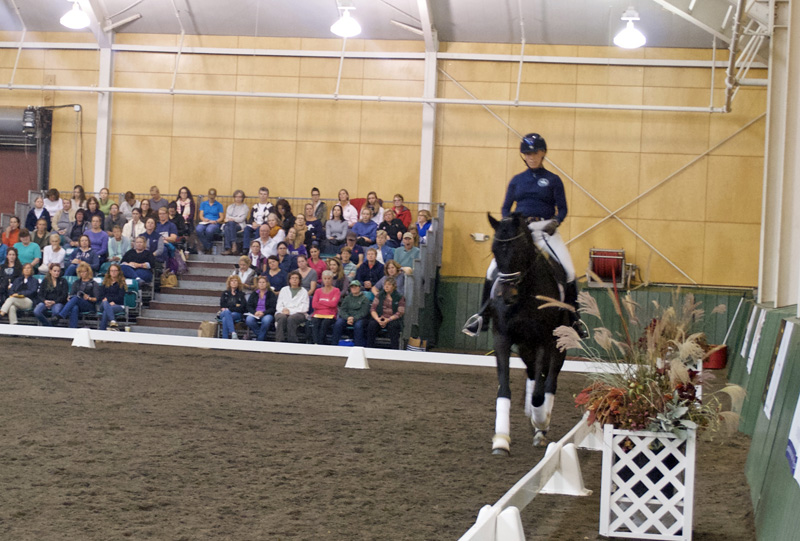
Karin Persson and Giuliano B. Photo by Sara Bradley
Clearly a crowd favorite, this horse is a special creature, and Karin is a terrific rider who is a pleasure to watch. My expert opinion is that we shall soon see this pair winning everything (you heard it here first).
After the excellent training yesterday, they went right to work with canter adjustability to improve walk-canter-walk. This was easy for the horse, so Hester decided a challenge was in order. They worked on some playful flying changes in sequence, with the goal to have many perfect singular changes in a row. He advised Karin to use her heel—rather than a sweeping leg—in her changes for a clearer aid. He also emphasized the importance of keeping the rhythm in between changes.
They played with some trot work, allowing the horse to gain power in medium trot and then use that power to develop balanced collection.
The third level riders once again were Katherine Poulin and Jannike Gray. These two women cruised into the arena looking like business, with horses prepared to accept some challenges.
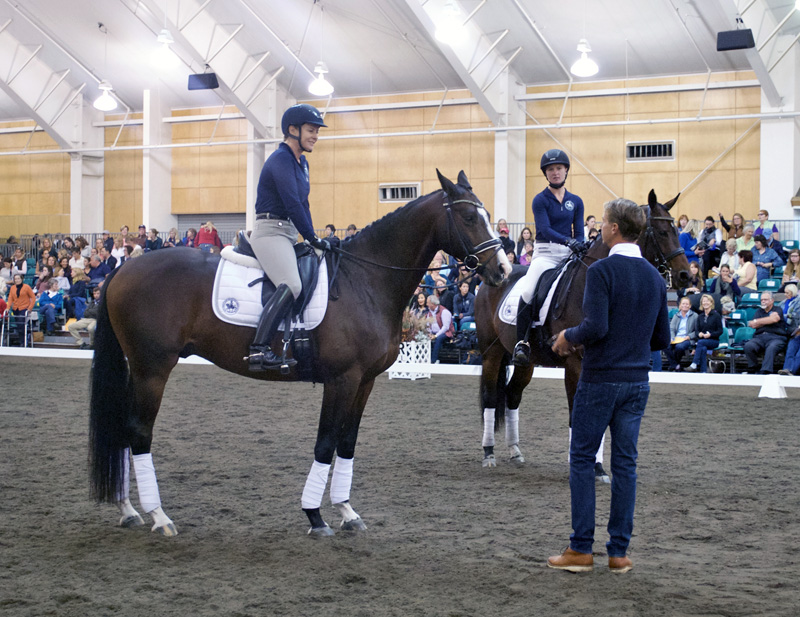
Katherine Poulin and Jannike Gray chatted with Carl Hester. Photo by Sara Bradley
Jannike got right to it, working toward improving bend in canter half-pass by looking at the inside hind (literally, leaning over and peeking at the horse’s hind hock). “A great way to get your body in balance to encourage bend,” said Hester, and he followed that with the sage advice of, “Don’t do that in competition though—unwise!” which of course brought many laughs from the crowd.
Jannike continued on to work sequential changes, with improved results after the work on Day 1. “Rhythm, rhythm, rhythm,” chanted Hester as they worked to develop a steadier canter.
Katherine used transitions between short and long canter strides to bring more expression to the changes. This was a great exercise that consisted of a smaller collected canter, followed by three forward strides of canter into a flying change. This was a great way to bring more elasticity and expression to this horse’s flying change work. Hester stressed “tempo control” with this horse, to bring more suppleness to his large gaits. “How can anything be supple if you keep it in the same place?” he asked. “Don’t be afraid to change the tempo—make him smaller, then bigger, and see how he reacts.”
Shannon Dueck and Molly Maloney again served as the Prix St. Georges and Intermediaire I riders. Molly and Felissimo got right to work on their canter. “We know you can trot, Molly, so you will work canter,” Hester said cheerfully.
While working on the collected pirouette canter he had this advice: “Stay there, in collection, until the horse relaxes,” regarding her horse’s tendency to want to leave the collected canter. “Without adjustability in the canter, the pirouette won’t be good,” he warned.
ADVERTISEMENT
After a few laps, they started on working pirouettes. Hester had Molly shift her hands more to the inside to bring the horse’s shoulders around the haunches, and the pirouette was immediately better. On the topic of better bend, he said it’s like “the wall of death” when there is no bend in the pirouette. They then worked the pirouettes around Hester to practice bringing the shoulder around the haunch and to perfect the size. “What’s the golden rule of a pirouette?” he asked Molly.
“To have you standing there!” she replied. Wise woman. We all need a Carl Hester permanently in our arenas!
At the start of the session, Hester said of Shannon’s mount Bourgogne, “That looks like a different horse today!” (He was spicy the day before!)
Shannon worked on a series of zen-like exercises with her horse. On a big circle they worked transitions from canter to halt on a relaxed rein. They followed this up with walk-to-canter transitions, where she offered him the rein, and his tension dissipated nicely. His shoulders became better, and he stopped looking with horror at the audience.
“I’d just work on a circle getting the canter right. I know he can do things, but he’ll do them better if the canter is right,” Hester advised.
They then worked on precision in the Prix St. Georges lateral work—making the circle the correct size and keeping completely steady rhythm in the trot. Hester gave her trouble for making her 8-meter circles huge and advised her to ride each quarter of the circle as an individual unit.
Next time my circles get wonky, I’m going to be sure to tell my trainer that it’s no big deal—Shannon makes her circles large too! (That should work well for me.) It was great fun watching this horse do his trot work, as he moves like a gazelle.
After the lunch break, we rolled out the small tour riders Adam Steffens and Emily Smith.
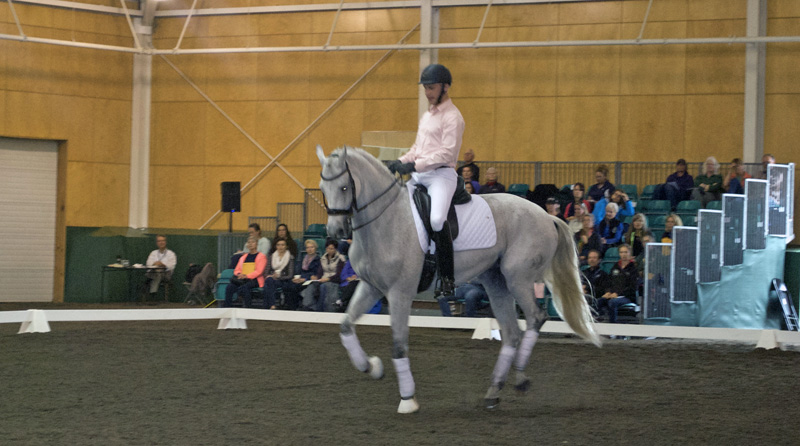
Adam Steffens and Zikomo De Grand. Photo by Sara Bradley
Adam continued pirouette work today with travers on centerline and working pirouettes in the corners. “It is important to work the challenging exercises when the horse is still fresh,” said Hester. “This exercise stops the horse from thinking about the difficulty of the movement.” Exercises then included medium canter in travers on the centerline, to push the horse into happy expression.
After the canter work, Adam played with medium trot to collection transitions, encouraging Zikomo De Grand to push forward to the hand in collection. “Follow him,” coached Hester. “Feel your hands going towards his mouth.”
When I spoke to Adam, he had this to say about his symposium experience: “Not working so hard was the takeaway message for me. Well… me not working so hard, that is,” he said with a laugh. “It was great to be making sure my horse was more honest to my aids, and I wasn’t manufacturing gaits, rather I was making him more honest. Also I appreciate how Carl is sympathetic to the horse. Every movement is designed to make the horse feel good about himself!”
After a very brave ride yesterday, working to improve her contact and bring her horse much more open and uphill, Emily Smith entered the arena looking ready to prove herself.
Hester began her session by saying, “Emily—show me an uphill canter!”
You could hear a pin drop as she picked up a canter and circled the arena twice. Not a sound was made. And then, Hester spoke: “Emily…. I’m speechless!”
And the crowd went crazy!
They went on to school the Prix St. Georges zigzag and the tempi changes with ease.
She completely nailed it. She won the bad a** award for the weekend—she was willing to make some big changes for big results in a high pressure situation in front of the 950 people.

Emily Smith. Photo by Sara Bradley
I was able to catch up with Emily after her ride, and she was jubilant. “I was thrilled with today! When I first picked up the canter I was so nervous because Carl was so quiet. I continued around the arena, and when he told me he was happy, I was so relieved and excited!” she said. Emily has had her horse, whom she purchased from a family friend, for three years. While their Young Rider career has come to a close this year, she looks forward to riding him in the Under-25 (once he gets his ones, she says!).
Ashley Madison, a native Mainer, riding Lugano was the developing Grand Prix candidate.
Her horse is 17 years old, but he is still a sassy boy when he wants to be! Hester had Ashley work on creating good discipline without any fighting. They worked on halts directly into the corners to gain his respect in a polite way. He encouraged Ashley to ride him forward in each stride through every step of trot half-pass, which created wonderful expression.
ADVERTISEMENT
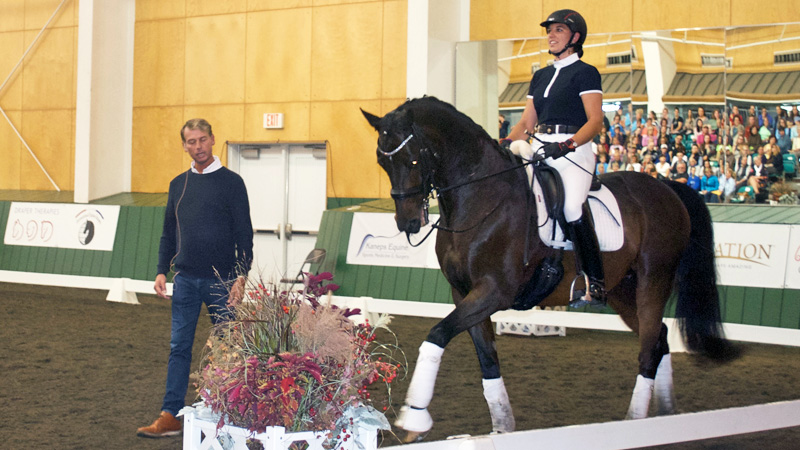
Carl Hester helping Ashley Madison with Lugano. Photo by Sara Bradley
“Stop him from running through your hands and telling you how things will be done! You wouldn’t let your husband treat you like that would you?” he teased. (Clearly, Ashley would not, as she quickly reminded Lugano of who the boss is!)
Lugano enjoys sightseeing in the walk, so they worked walk zigzags to keep him busy rather than tense. “You must think quicker than your horse,” was the advice on this point.
Carl had Ashley work piaffe with him walking alongside as a speed challenge. “Hey, I’m back here,” he exclaimed as Ashley crept away. He encouraged her to let the horse find his own strength in the movement, and to almost think rein back to improve the sit.
In the passage they worked leg yield exercises to increase the push from the hind leg, which made the rhythm of the movement much steadier.
Hester was very positive about Lugano’s work, encouraging Ashley to tackle the CDI arena next year.
Jane Karol and Sunshine Tour continued the Grand Prix experience.
The focus of the session the day before was finding forward balance in the passage and then transitioning to an “almost” piaffe, in order to keep the activity. This was an excellent set-up for today’s focus.
From the ground, Hester assisted Jane with the passage. Walking alongside them he coaxed the mare from the ground into more active movement. Again, “good rhythm is a must,” was stressed (and honestly, not much of an issue. Those girls had rhythm!).
He then assisted them from the ground in piaffe, which he encouraged her to start from a very active 10-meter circle. With some gentle guidance some great piaffe was shown. “She is going to be gorgeous,” Hester complimented, as the mare became more and more balanced and cooperative.
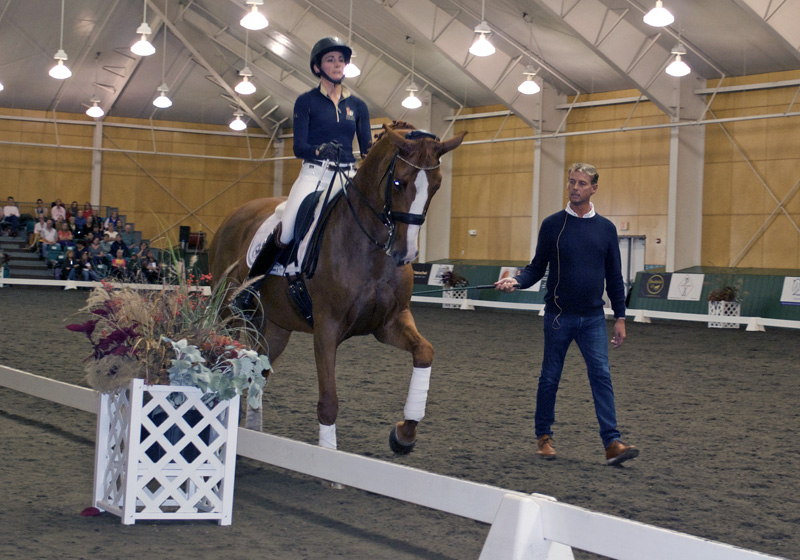
Carl Hester helping Jane Karol with Sunshine Tour’s piaffe. Photo by Sara Bradley
They schooled canter pirouettes, and we were reminded to “never finish the pirouette with a hard one,” meaning, after a small pirouette is ridden it is wise to ride a larger one, to train the horse to continue after the challenge is over.
After Jane’s horse showed a pirouette with haunches leading, Hester encouraged her to ride starting with a clear shoulder-in, then to bring the forehand around an imaginary clock. She brought the forehand to 2, then 4 and so on. This was one of those “Why didn’t I think of THAT?” exercises—so simple, so effective, and the crowd appreciated the effort.
Jane was delighted with her lovely mare’s performance and the opportunity to work with Hester. “The best moment for me was while working on the piaffe/passage transitions,” she said. “Carl had me give the reins more than I may have tried before, and the response from my horse was amazing. Intellectually, one may know that is the correct aid, but without expert eyes on the ground it can be hard to find the timing. With Carl’s help with the timing, we had one of those lightbulb training moments, which for me was very special.”
Laura Noyes Putnam wrapped up the Grand Prix for us on Galveston. Another Mainer, Laura is the head trainer at Scarlet Day Farm in Gray, Maine.
Hester talked about the one-tempi changes and how important it is for the horse to follow your aid, rather than you waiting to see what he has done. “By the time you have checked in, he is doing something else,” he said.
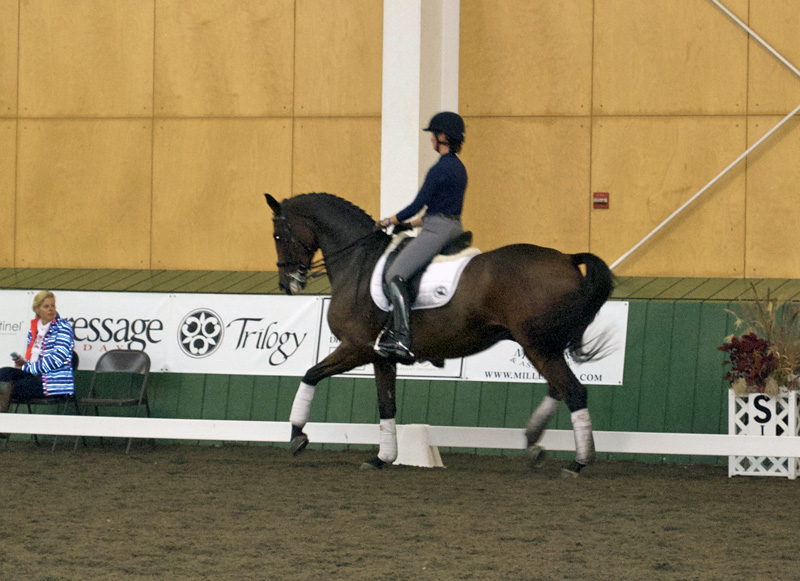
Laura Noyes Putnam rode Galveston in the symposium. Photo by Sara Bradley
Moving right to changes with Laura, he suggested that she think of her first change in a line as her second change. This will help to avoid the overriding that can cause a croup-high change. Fixing that created much more harmony in the two-tempi work. “Rhythm, rhythm, rhythm,” sang Hester, once again reminding all of us not to make arrhythmic flying changes.
It took Laura’s horse a couple attempts to follow her one-tempi change aids, as he became nervous, but once he did they were quite nice. Hester had her do fewer changes and to keep a longer leg throughout, which created less mental chaos. He had her drop her stirrups for some canter work to lengthen her (already rather long) legs. From there, they worked some rolling ones to further improve the quality of the first change. (Without stirrups—clearly trying to steal Emily’s bad a** award!)
After the hard work on the tempis, Hester let them finish up with passage, which is this horse’s favorite activity. Laura was encouraged to make the passage quicker and less labored. A few medium trot transitions quickly improved this, and the horse finished up expressive and happy.
In his closing words Hester was very complimentary to all the horses and riders he worked with over the weekend. “It was a lot of horses, GOOD horses and good riding,” he said. “Perhaps I’ll have to come back again?”
If the uproarious standing ovation at the end of his words was an indication, yes. We would love to have you back!!
In conclusion, a huge thanks to the New England Dressage Association for a world class weekend, to Pineland Farms and staff for hosting, to the demo riders for putting themselves on stage, and to the volunteers for keeping the weekend running like clockwork.
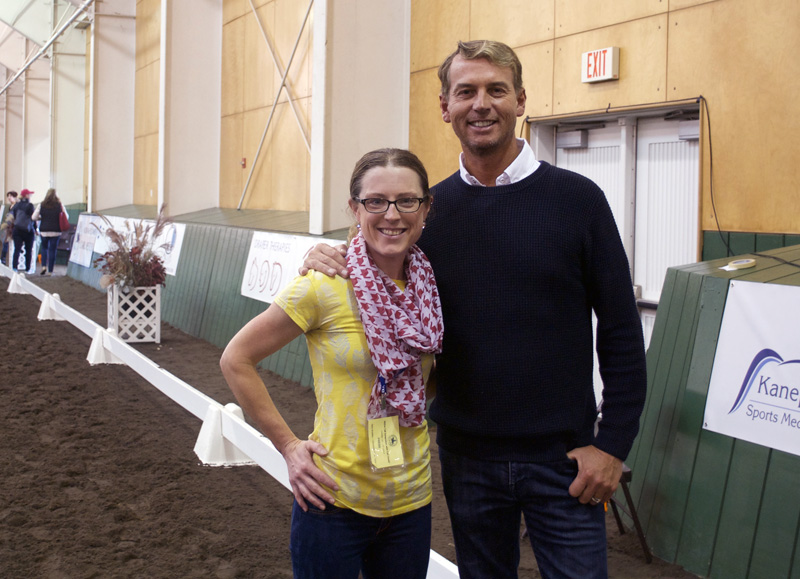
The author (left) with Carl Hester.
Save







